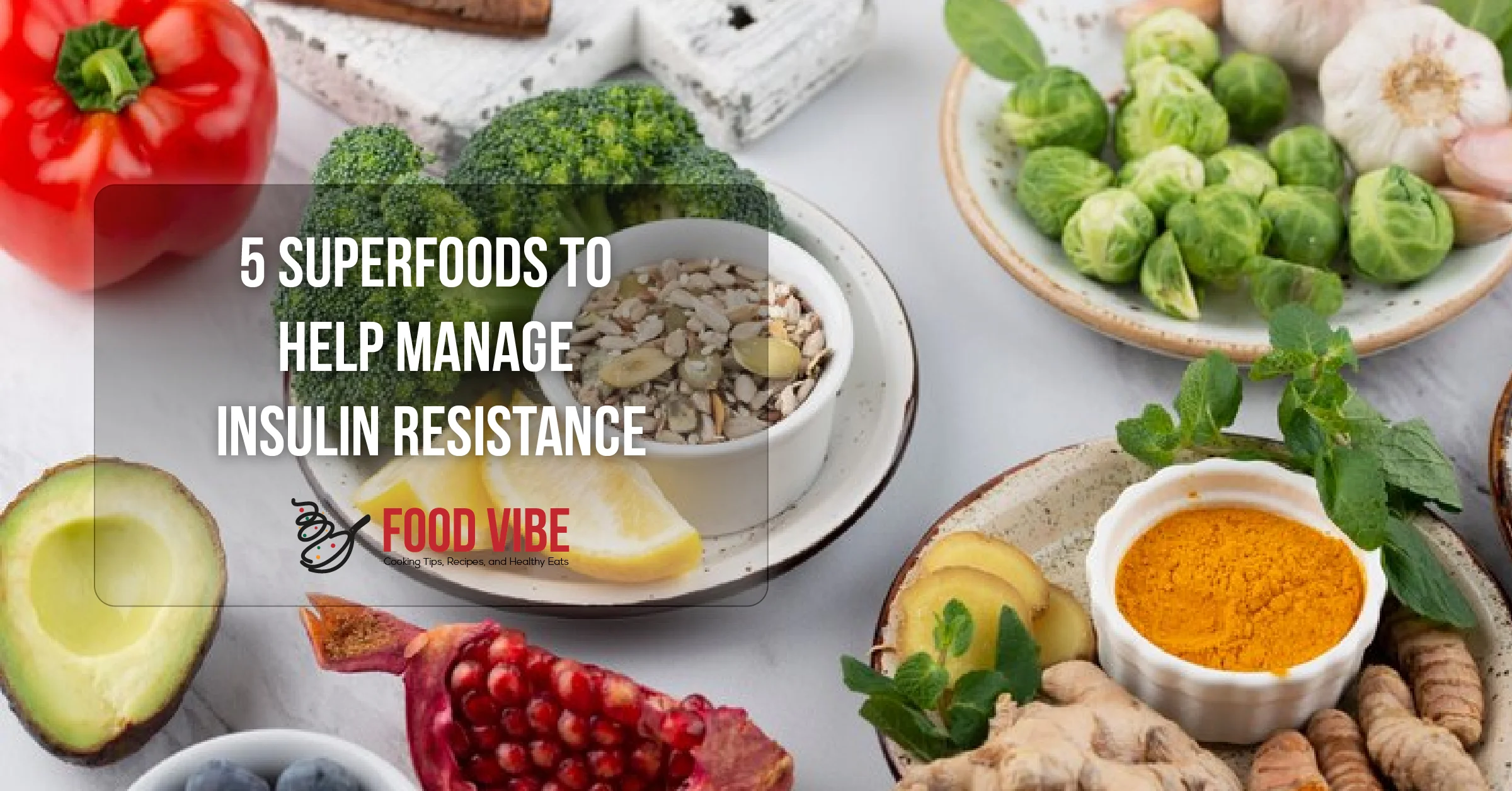5 Superfoods to Help Manage Insulin Resistance
In today’s health-conscious world, it’s key to know how to fight insulin resistance. This article shows you five superfoods that are tasty and help manage insulin resistance. Adding these foods to your diet can help control your blood sugar and boost your health. Let’s look at the 5 best foods to improve insulin resistance and how they can help your diet.
Table of Contents
Understanding Insulin Resistance
Insulin resistance is a growing concern. It can lead to serious health issues like type 2 diabetes. By understanding this condition, you can take significant steps toward managing it with food and lifestyle adjustments.
What is Insulin Resistance?
Insulin resistance happens when your body’s cells don’t respond well to insulin. Insulin is the hormone that helps control blood sugar levels. Your body might make more insulin, leading to high blood sugar levels over time.
Many factors can cause insulin resistance. These include obesity, a sedentary lifestyle, and genetics. It’s important to address these factors to improve your health and well-being.
Symptoms and Causes of Insulin Resistance
It’s important to recognize the symptoms of insulin resistance early. Common signs include:
- Fatigue
- Increased hunger
- Weight gain
- Difficulty concentrating
The causes of insulin resistance often relate to lifestyle choices and hormonal factors. A sedentary lifestyle, poor diet, and hormonal imbalances can all play a role. Knowing these symptoms and causes is key to managing insulin resistance with food effectively. By making informed choices, you can work toward a healthier life.
The Importance of Diet in Managing Insulin Resistance
Managing insulin resistance through diet is key to better health. What you eat affects how your body uses insulin. By picking the right insulin resistance foods, you boost insulin sensitivity. This leads to better metabolic function.
How Diet Impacts Insulin Sensitivity
A good insulin-sensitivity diet is vital for insulin response. Foods high in fiber, antioxidants, and healthy fats improve insulin action. These foods keep blood sugar stable, giving you steady energy and preventing big spikes.
Key Nutrients to Focus On
Adding certain nutrients can really help. Make sure to include:
- Magnesium – It boosts metabolic health and insulin action.
- Chromium – It makes insulin work better and keeps blood sugar in check.
- Omega-3 fatty acids – In fatty fish and flaxseeds, they cut inflammation and boost insulin response.
By focusing on these nutrients, you can make a diet that supports insulin sensitivity and overall health. Knowing how your diet affects you gives you the power to improve your health.

5 Best Foods to Improve Insulin Resistance
Adding the right foods that help insulin resistance can greatly improve your health. Here are 5 great options to try:
Food 1: Leafy Greens
Leafy greens like spinach and kale are full of vitamins and minerals but low in calories. They have a low glycemic index, which keeps blood sugar stable. They also provide important nutrients for overall health.
Food 2: Berries
Berries, like blueberries and strawberries, are full of antioxidants and fiber. They help lower insulin levels and reduce inflammation. Enjoy them as a snack or blend them into smoothies for a healthy boost.
Food 3: Fatty Fish
Fatty fish, such as salmon and mackerel, are rich in omega-3 fatty acids. Eating them regularly can improve insulin sensitivity. Grill or bake them for a tasty meal.
Food 4: Nuts and Seeds
Nuts like almonds and seeds like chia are full of healthy fats, fiber, and protein. These snacks can help regulate blood sugar and improve metabolic health. They’re a great addition to your daily routine to support insulin management.
Food 5: Whole Grains
Switching to whole grains like quinoa and brown rice can help with blood sugar levels. They’re high in fiber, which helps keep insulin levels stable. Unlike refined grains, they don’t cause spikes. Adding them to your meals can make your diet better.
| Food | Key Benefit | How to Incorporate |
|---|---|---|
| Leafy Greens | Low in calories, high in nutrients | Salads, smoothies, sautéed |
| Berries | Rich in antioxidants and fiber | Snacks, desserts, smoothies |
| Fatty Fish | Source of omega-3 fatty acids | Grilled, baked, in salads |
| Nuts and Seeds | Packed with healthy fats and protein | Snacks, toppings, in cereals |
| Whole Grains | High in fiber, stabilizes blood sugar | Bowls, side dishes, salads |
Insulin Resistant Diet: What to Include
Managing insulin resistance means paying attention to the fats and fibers you eat. Knowing what to focus on can help improve your insulin sensitivity and health. Healthy fats and high-fiber foods are key to a good diet.
Healthy Fats vs. Unhealthy Fats
Eating healthy fats is good for reducing inflammation and improving insulin sensitivity. Avocados, olive oil, and fatty fish are great choices. They’re full of nutrients that help cells work well. On the other hand, avoid unhealthy fats, especially trans fats in processed foods. These can make insulin resistance worse.
Choosing High-Fiber Foods
High-fiber foods are crucial for a regulated blood sugar diet. Beans, legumes, whole fruits, and veggies slow down glucose absorption. This helps keep insulin levels stable. Eating a variety of these foods helps maintain energy and improves insulin response.
| Type of Fat | Examples | Health Impact |
|---|---|---|
| Healthy Fats | Avocados, Olive Oil, Fatty Fish | Lower inflammation, Improve insulin sensitivity |
| Unhealthy Fats | Processed snacks, Fried foods | Exacerbate insulin resistance, Increase inflammation |
| High-Fiber Foods | Benefits |
|---|---|
| Beans | Slow glucose absorption |
| Legumes | Enhance satiety |
| Whole Fruits | Rich in vitamins and minerals |
| Vegetables | Support digestive health |

Foods to Lower Insulin Levels
Eating low glycemic index foods is great for managing insulin resistance. These foods keep your blood sugar steady and prevent big insulin spikes. This is key for keeping your insulin levels stable.
Benefits of Low Glycemic Index Foods
Low glycemic index foods do more than just control insulin. They also boost heart health, improve digestion, and give you more energy. By avoiding sudden blood sugar changes, you get lasting energy and less hunger.
Examples of Foods to Incorporate
Adding different foods to your diet can lower insulin levels and improve health. Here are some good choices:
- Sweet potatoes
- Most fruits, like apples and berries
- Beans, such as black beans and lentils
- Non-starchy vegetables, including spinach and broccoli
- Whole grains like quinoa and brown rice
| Food Item | Glycemic Index | Benefits |
|---|---|---|
| Sweet Potatoes | 44 | Rich in fiber and vitamins |
| Apples | 36 | High in antioxidants and hydration |
| Lentils | 29 | Excellent source of protein and iron |
| Spinach | 15 | Packed with vitamins and minerals |
| Quinoa | 53 | Complete protein with essential amino acids |
Adding these foods to your meals can lower insulin levels and support a healthier lifestyle. Making smart food choices is crucial for your health and managing insulin resistance.
Regulate Blood Sugar Diet: Meal Planning Tips
Creating a meal plan for insulin resistance can greatly improve your health. The key is to make a balanced plate. This should include lean proteins, healthy fats, and fiber-rich carbs. This formula helps control your blood sugar levels.
Creating a Balanced Plate
A balanced plate focuses on the right food amounts. Fill half with non-starchy veggies, a quarter with lean protein, and the last quarter with whole grains. Add healthy fats like olive oil or avocado for taste and nutrition.
Portion Control Strategies
Controlling portions is key in meal planning. Using smaller plates helps you eat the right amount. Measuring food ensures you stay within calorie limits, which is important for insulin management. Also, drink 8 ounces of water before meals to help control hunger.
| Food Group | Portion Size | Suggestions |
|---|---|---|
| Non-Starchy Vegetables | 1-2 cups | Spinach, broccoli, bell peppers |
| Lean Protein | 3–4 ounces | Chicken, tofu, fish |
| Whole Grains | 1/2 cup | Quinoa, brown rice, whole grain pasta |
| Healthy Fats | 1-2 tablespoons | Olive oil, nuts, seeds |
By focusing on a balanced plate and portion control, meal planning helps manage your health. These habits not only regulate blood sugar but also lead to lasting lifestyle changes. Creating a routine is key to reaching your health goals.

Insulin Sensitivity Diet: Avoiding Problematic Foods
Managing insulin resistance means watching what you eat closely. Avoiding certain foods can help improve your insulin sensitivity. We’ll look at foods to limit or avoid and why processed foods are a big deal.
Foods to Limit or Avoid
Keeping blood sugar stable is key. Here are some foods to steer clear of:
- Sugary snacks like candies and pastries
- White bread and other refined carbs
- High-fructose corn syrup in sodas and desserts
These foods can cause blood sugar to rise too fast. This can hurt your insulin sensitivity.
Understanding Processed Foods
Processed foods are a big worry for insulin resistance. They often have unhealthy fats, too much sugar, and sodium. Knowing how to read food labels and choosing whole foods is crucial. Here’s a look at the difference:
| Food Type | Processed Foods | Whole Foods |
|---|---|---|
| Typical Example | Chips, Frozen Meals | Fruits, Vegetables |
| Sugar Content | High | Low |
| Sodium Content | High | Minimal |
| Healthy Fats | Often Unhealthy | Rich in Healthy Fats |
Choosing whole foods helps your body manage insulin better. It keeps you away from bad foods.
Managing Insulin Resistance with Food: Practical Tips
Managing insulin resistance with food is all about smart eating. Adding superfoods to your diet can greatly improve your health. Foods like leafy greens, berries, and fatty fish boost insulin sensitivity. These foods, when added to meals or snacks, offer lasting health benefits.
Incorporating Superfoods Into Your Daily Routine
Begin your day with spinach or kale in your smoothie. Top your yogurt or oatmeal with berries for a healthy snack. For lunch, try a salad with salmon for its omega-3s. Nuts and seeds are great for a mid-afternoon pick-me-up. Using superfoods daily is crucial for managing insulin resistance.
Staying Consistent with Your Meal Plan
Consistency is key in managing insulin resistance. Sticking to your meal plan helps keep blood sugar levels stable. Preparing meals ahead of time ensures you make healthy choices, even when eating out. Aim for a balanced plate with healthy fats, proteins, and fiber-rich carbs. This dedication to your meal plan leads to lasting health improvements.
| Superfoods | Benefits | Ways to Incorporate |
|---|---|---|
| Leafy Greens | Rich in nutrients, low in calories | Add to smoothies or salads |
| Berries | High in antioxidants; improve insulin sensitivity | Top on yogurt or oatmeal |
| Fatty Fish | Omega-3 fatty acids support heart health | Include in salads or main meals |
| Nuts and Seeds | Healthy fats and protein; promote satiety | Use as snacks or toppings |
| Whole Grains | High in fiber; aids digestion | Opt for brown rice or whole grain bread |
Conclusion
Managing insulin resistance with food is key to better health. Eating foods like leafy greens, berries, and healthy fats boosts your insulin sensitivity. These changes improve your health and give you control over it.
It’s important to make these foods a regular part of your diet. Try adding nuts to your breakfast or choosing whole grains over refined carbs. These small changes can make a big difference in managing insulin resistance.
Choosing natural foods helps keep your blood sugar balanced and improves your health. By making these dietary changes, you’re on the path to better insulin management and lasting wellness.
Also Read: How to Use Apple Cider Vinegar for Weight Loss in Just 7 Days
FAQs
What are the best foods to improve insulin resistance?
The best foods to improve insulin resistance include leafy greens, berries, fatty fish, nuts and seeds, and whole grains, as they help regulate blood sugar and boost insulin sensitivity.
How does diet impact insulin sensitivity?
A diet rich in fiber, healthy fats, and key nutrients like magnesium and omega-3 fatty acids can improve insulin sensitivity by stabilizing blood sugar levels and reducing inflammation.
What foods should I avoid to manage insulin resistance?
Avoid sugary snacks, refined carbs, and processed foods high in unhealthy fats and added sugars, as they can spike blood sugar and worsen insulin resistance.
Can low glycemic index foods help lower insulin levels?
Yes, low glycemic index foods like sweet potatoes, beans, and non-starchy vegetables help stabilize blood sugar and prevent insulin spikes, supporting better insulin management.
How can I incorporate superfoods into my daily diet?
Add leafy greens to smoothies, top yogurt with berries, include fatty fish in meals, snack on nuts and seeds, and swap refined grains for whole grains to boost insulin sensitivity.














Post Comment